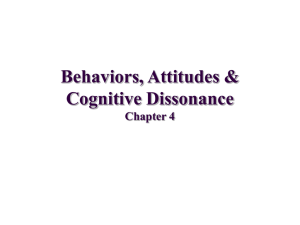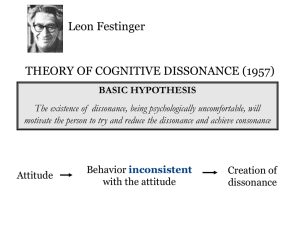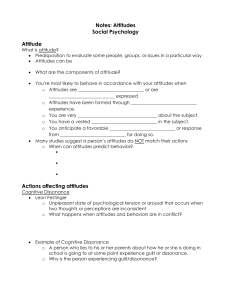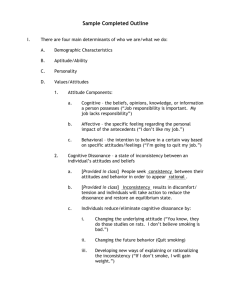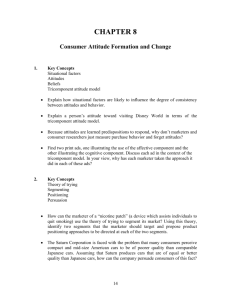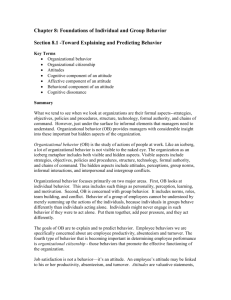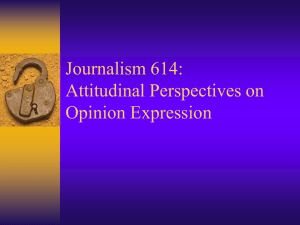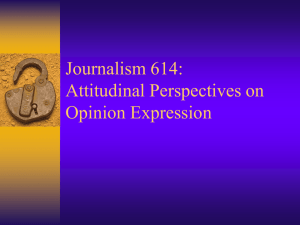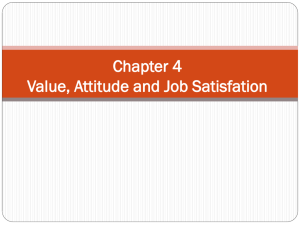Attitudes
advertisement
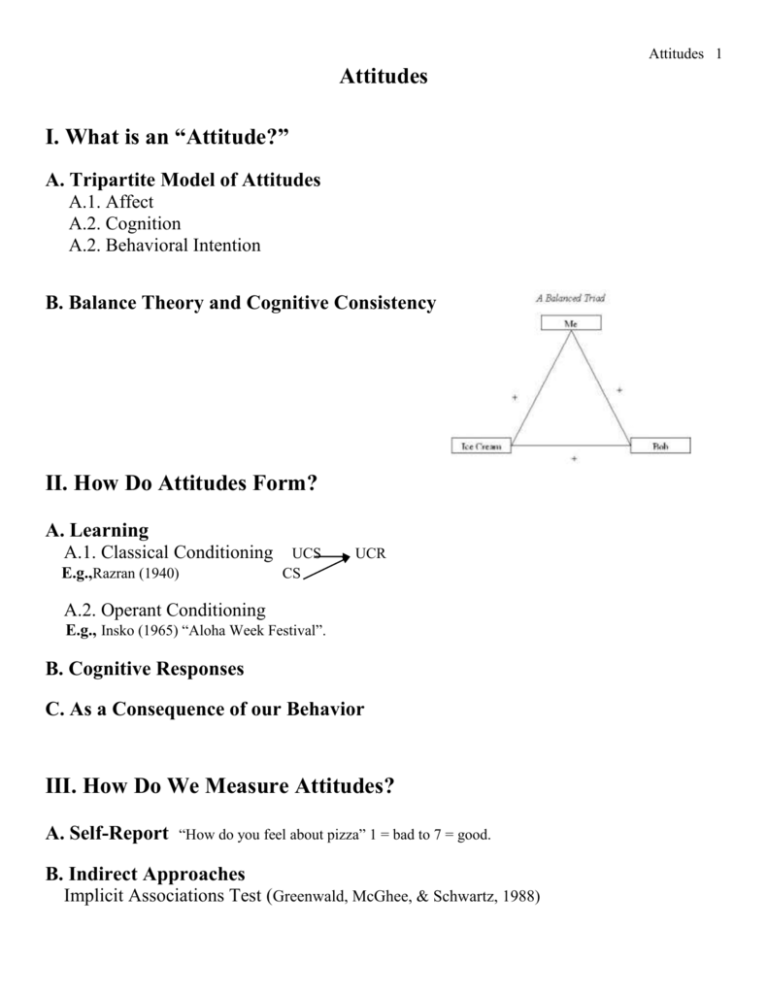
Attitudes 1 Attitudes I. What is an “Attitude?” A. Tripartite Model of Attitudes A.1. Affect A.2. Cognition A.2. Behavioral Intention B. Balance Theory and Cognitive Consistency II. How Do Attitudes Form? A. Learning A.1. Classical Conditioning E.g.,Razran (1940) UCS CS UCR A.2. Operant Conditioning E.g., Insko (1965) “Aloha Week Festival”. B. Cognitive Responses C. As a Consequence of our Behavior III. How Do We Measure Attitudes? A. Self-Report “How do you feel about pizza” 1 = bad to 7 = good. B. Indirect Approaches Implicit Associations Test (Greenwald, McGhee, & Schwartz, 1988) Attitudes 2 IV. Attitude Affects Behavior A. Low-to-No Association in Initial Research E.g., La Pierre (1934) B. Methodological Improvements Reveal Attitude – Behavior Link Fishbein and Azjen 1. Multiple Act Criterion 2. Specificity of Attitude and Behavior E.g., Weigel & Newman (1976) Time 1………….Attitudes toward environmental protection embedded in a larger survey 3months……….. sign petitions opposing costal drilling, nuclear plants, regulate emissions 4.5 months…….. telephoned “Participate in road side litter clean up” and who actually participated 6 months………. telephoned “Participate in recycling program” and who actually participated C. Theory of Reasoned Action 1. Attitude Toward The Behavior (Azjen & Fishbein) 2. Subjective Norms Attitudes 3 V. Behavior Affects Attitude A. Cognitive Dissonance as Cognitive Consistency (Leon Festinger) 1. Relationship Among Cognitions: consonant, dissonant, irrelevant 2. Cognitive Dissonance 3. Intensity of Dissonance 4. Reducing the Dissonance a. Change One of the Cognitions b. Add Consonant Cognitions c. Change the Importance of the Cognitions Classic studies of Cognitive Dissonance E.g., Festinger and Carlsmith (1959 pegboard task. E.g., Aronson and Mills (1959) initiation B. Cognitive Dissonance as Self-Protection Reinterpreted as a response to a threat to the self, rather than a response to cognitive inconsistency. Efforts to reduce the dissonance are viewed as efforts for self-protection. 1. Factors Necessary to Arouse Dissonance a. Behavior Produces an Aversive Event AND b. Person Accepts Responsibility for the Aversive Event 1. Free Choice 2. Foreseeable Consequences 2. Example of Process + Consequence Behavior No Diss Not Responsible - Consequence Reinterpret Consequences Dissonance Reinterpret Responsibility Responsible E.g., Nel, Helmrich & Aronson (1969) Incentive (high vs low pay for counterattiduinal message) X Audience (Promessage, Antimessage, Undecided) Attitudes 4 C. Cognitive Dissonance: Self-Protection as Consistency D. Bem’s Self-Perception Theory (Daryl Bem) E. Evidence of Dissonance-Arousal Eg. Zanna & Cooper (1974): (Low vs High choice for counter attitudinal essay) X (alleged effect of a Pill) Attitude toward Issue L H L H Tense H H H H L H L H H L H L H No-effect Relax E.g., Cooper, Zanna, & Taves (1978) (Low vs High choice for counter att essay) x (Placebo vs Tranquilizer) Attitude toward Issue H H H H L H L H Placebo L H L H Tranquilizer Attitudes 5 VI. Persuasion: Active Attempt to Change Attitude Persuasion is an active attempt to change attitudes. A. Message Learning Approach Carl Hovland The person must ATTEND, COMPREHEND, and RETAIN the message. A.1. Characteristics of the Source: Who is Persuasive? a. Credibility b. Attractiveness A.2. Characteristics of the Message: What Messages are Persuasive? a. Number of Arguments b. 1 sided vs. 2 sided messages A.3. Characteristics of the Target: Who is persuaded? B. Cognitive Response Theory Greenwald and Brock B.1. Distraction E.g., Festinger and Maccoby (1964) E.g., Osterhouse and Brock (1970) B.2. Forewarning C. Elaboration Likelihood Model Petty and Cacioppo (1981) C.1. Two Routes to Persuasion C.1.a. Central Processing C.1.b. Peripheral Processing C.2. Motivation & Ability Determine The Route Attitudes 6 C.3. Paradigm in which Petty & Cacioppo Tested the ELM Three variables were manipulated: Involvement, Source Cue, and Message Strength. C.3.a Involvement C.3.b Source Cue C.3.c Message Strength Low Involvement S W S W S W S W S W S W High School Student Professor High Involvement S S S S S S S S S S S W W W W W W W W High School Student Professor
